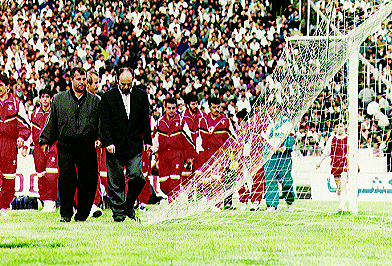

By Morteza Qolamzadeh
Tehran, Iran
Since 1994, when the Iranian national football team got knocked out of the qualifying rounds of the World Cup games in the United States and failed to qualify for the Asian championship, Ali Parvin has dropped out of sight.
One might think that the embarrassing defeats forced Parvin to retire as the leading figure of Iran's greatest pastime. It has even been rumored that the living football legend has been videotaped admitting to "moral corruption" (fesad akhlaqi) and pledging to stay away from the sport. Not exactly.
Parvin has been banned from coaching any football team or stepping into any stadium. He is an exile in his own country. But the reasons for his disappearance have little to do with poor coaching or morals.
Arguably, Parvin is one of the most successful and popular sportsmen in Iranian history. He is the only Iranian football player to clinch the Asian championship (Peking, 1990) both as player and coach of the national team. He is the only national coach to have brought the Asian Cup to Iran since the 1979 revolution.
So what went wrong?
Many who closely follow football, believe Parvin became the chief target of long-running attempts by some officials, led by one Mohammad Safizadeh, to eliminate taghouti-era football stars from the football field.
Safizadeh, who recently purchased the daily Abrar, is a deputy agriculture minister and manager of the ministry's Keshavarz football team. He headed Iran's football federation until the defeat of the national team in Qatar at the second round of qualifying matches for the 1994 World Cup.
Before his ouster from the federation, Safizadeh made sure Parvin -- at the time the national coach and the coach of Iran's most popular team, Persepolis -- would never return to football again.
But defeat in Qatar was not the reason for Parvin's ouster, but a convenient excuse.

Differences between the two men date back to 1990, when for the first time after the revolution, a serious attempt was made at putting together a football team that could challenge the long dominance of Persepolis and Esteqlal (ex-Taj).
Safizadeh set out to create Keshavarz with the financial backing of the Agriculture Ministry. Top money was spent, with some success, to lure national players from Esteqlal and Persepolis. But Keshavarz was never able to weaken Tehran's two most popular teams by becoming a so-called "third pole."
Why? You guessed it. Many Persepolis players remained loyal to Parvin and refused to join Keshavarz. Besides, the new rival team could not find a coach that was as good. And to top it all, Parvin was one of the few leaders in football who publicly ridiculed the whole "third pole" theory.
Spending millions did not diminish Parvin's influence but the loss of national pride put a serious dent into it. Iran's consecutive international defeats in 1994 provided the perfect ammunition. In a short time, Parvin left the national team and no longer coached Persepolis.
But to the dismay of his spiteful enemies, Parvin has only dropped out of sight, not out of mind or heart.
Every time Persepolis or national team players step onto the field, the stadium is filled with roars of "Parvin, Parvin."
